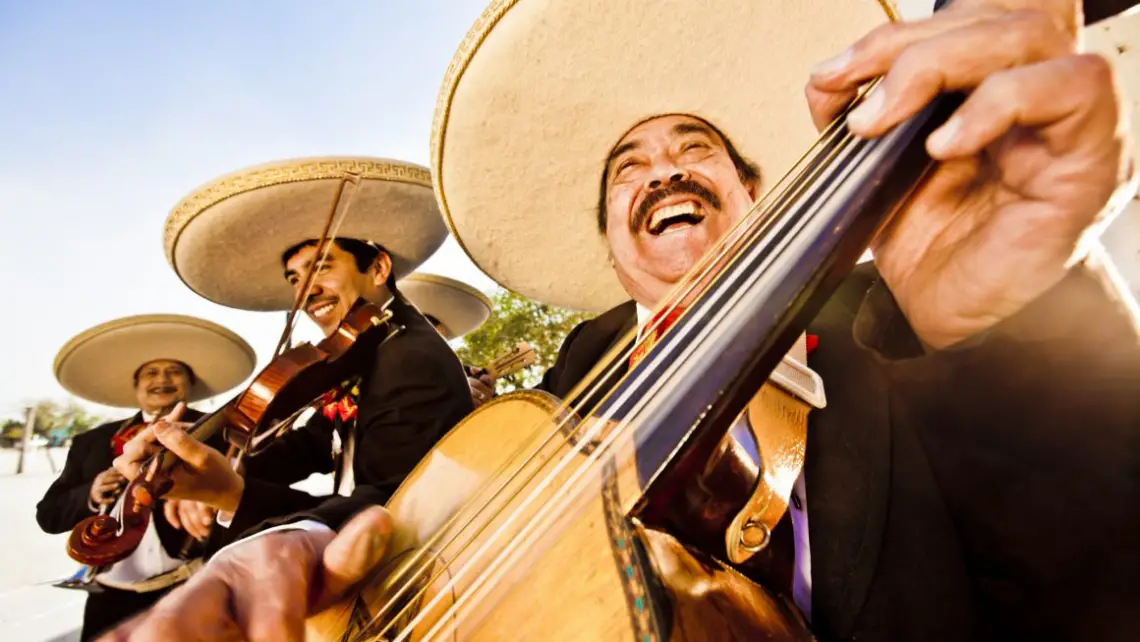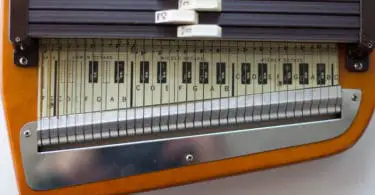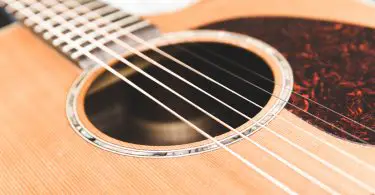Latin America, Portugal, and Cape Verde are all geographical areas known for having rich, vibrant, and distinct musical cultures. There are hundreds of stringed instruments in these Latin countries used for all sorts of different styles and genres.
These instruments each offer a unique sound tone that sets itself apart from all of the rest. Whether you are looking to spice up your musical collection, wanting to bring a unique and spirited sound to your music, or simply wanting to indulge in the rich history of Latin music, looking into Latin strings can be a fun and exciting venture.
Learning to play a new style will help you develop into an even more distinguished musician and may even help you come up with more original song ideas.
Below, we have provided an overview of some the more popular Latin strings available today, but keep in mind that this collection barely skims the surface of all of the distinct traditional Latin string options out there.
The Viola

Credit: Leptossomico mariojunio, via Wikimedia Commons
The viola is a name used for a variety of Latin instruments, and the specifications for each type of viola vary from country to country. The Brazilian viola is perhaps the most popular. It is a ten-string instrument with many tuning options, allowing it be embraced by a number of different styles of music. The bottom three sets of strings are tuned in various octaves, while the top two treble courses are tuned in unison.
The viola of Brazil is steel strung like those found in Portugal, is a bit smaller than the classical guitar, and is meant to have the luster of a twelve-string guitar, but on a much smaller body. It is made with a flat back and a fingerboard raised slightly above the front of the instrument.
The five courses of ten strings run to a flat guitar bridge that is typically glued to the front. In Olinda (NE Brazil), the Delvecchio viola is used by popular “cantor de viola” ensembles. These groups consist of two singers who each improvise a song while accompanying themselves on viola.
To purchase a Brazilian viola caipira, look here:
In Portugal, the viola also has five metal courses and is generally strummed to accompany singers. The use of violas in Portugal has increased, after many years of their declining popularity, and now Portuguese violas can be easily found all over the country.
Violas in Portugal are made using a variety of techniques, designs, and styles depending on the price range, guitar makers and their location, so it is difficult to establish specific viola names and types. The most well-known Portuguese viola is the viola braguesa or (viola da Braga), which is made and played around the town of Braga located between the Douro and Minho rivers.
Although less well-known, the viola de den cordes, is another viola constructed and played on Cape Verde, a set of islands off of the Northwest coast of Africa. The music on Cape Verde, which is very similar to Portuguese music, is usually made in small groups consisting of a guitar, a violin, a small cavaquinho, and a ten-string viola. The
The viola de den cordes is very similar in appearance to Brazilian and Portuguese violas, but instead of one straight sound hole located at the top of the body, it has two heart-shaped sound holes on the soundboard. The violas found on Cape Verde are only used for strumming.
The Cavaquinho

Credit: Lardyfatboy CC BY-SA 4.0, via Wikimedia Commons
The Cavaquinho and the ukulele both developed from the same Portuguese instrument known as the machete. Because of its convenient size, the machete became the perfect travel companion for sailors and explorers. It traveled all over the world, to Brazil and even Hawaii (it here eventually blossomed into the Ukulele).
In both Portugal and Brazil, the machete developed further into the Cavaquinho. That is why today there are two distinct versions of the cavaquinho, the Portuguese cavaquinho, and the Brazilian.
The cavaquinho is strung with four strings tuned in an open G chord, giving it the same relative pitch and sound as the ukulele. These strings go from low to high and are usually made of steel. Note that the cavaquinho can be retuned to match a ukulele’s tunings if a player is used to ukulele fingerings but wants to play a cavaquinho. The sound of a cavaquinho varies from a light ukulele-like sound to a more projected, rich and warm sound of a guitar.
The Brazilian Cavaquinho (also known as a cavaco) is a very popular instrument in Brazil and is used for Samba and Choro style music. Samba, developing in Rio de Janeiro in the early 20th century, is perhaps the quintessential music and dance genre to emerge from Brazil. It has a rich and syncopated rhythm with exuberant dance moves. Choro, also known as chorinho, is a Brazilian instrumental genre with an origin dating back to the end of the 19th century, also in the city of Rio de Janeiro.
A choro ensemble traditionally is made up of at least one solo instrument (flute, mandolin, clarinet, etc.) and either a cavaquinho, acoustic guitar or pandeiro as accompaniment instruments. Here, the cavaquinho plays the rhythm and harmony. The choro genre has an “upbeat and cheerful” rhythm, often using heavy improvisation among its performers. The Brazilian cavaquinho is used for both solo parts and accompanying vocals, and has become an essential part of Brazilian music.
Look here to purchase a Brazilian style cavaquinho:
The Portuguese cavaquinho is seen as the small guitar of Portugal. It looks like a miniature version of a Spanish guitar, but the sound hole, bridge and tuning head are similar to other small Latin strings, like the viola. It is made of four metal strings and is tuned differently than the Brazilian cavaquinho. There is also a Cape Verde version of the cavaquinho, which is bigger than the Brazilian and Portuguese versions. These are used to accompany singers with strumming and an occasional solo.
The Cuatro

Credit: Caballero1967 CC BY-SA 4.0, via Wikimedia Commons
The cuatro looks like a cross between a small guitar and a violin, and it has a flat back. The bridge of a cuatro is the same as what is found on a classical guitar, but both steel strung and nylon strung cuatros exist today. It is usually played with a flatpick or plectrum to either pick or strum chords, often with a rhythmic dampening of the strings with the players palm. The sound of a cuatro is something of a cross between a mandolin and a traditional 12-string guitar.
The cuatro’s roots can be traced back to the Portuguese Cavaquinho, which also has four strings. It is found in numerous forms among the guitar family of Latin America and the Caribbean region. It generally has four strings (cuatro means four in Spanish), but many modern cuatro designs feature more than four strings. In Colombia, Jamaica, Mexico and Suriname, the cuatro is commonly used to accompany singing and dancing ensembles.
The cuatro is perhaps the most popular in Puerto Rico and Venezuela and is the national instrument of both countries. The Puerto Rican and Venezuelan cuatro is used as an ensemble string for both secular and religious music. The Venezuelan cuatro has four strings and is tuned like the ukulele, but techniques for playing are different. It is typically used by rural peasant farmers and reflects the farmers’ European, Aboriginal and African ancestry.
The Puerto Rican cuatro differs from the Venezuelan cuatro. Over the years, more strings have been added to the original four. Today, the Puerto Rican cuatro has ten metal strings in five courses and is commonly used to play the melody lines in smaller ensembles.
Here are some examples cuatros that can be purchased today:
The Tiple

Credit: Andres Cabrera CC BY-SA 3.0, via Wikimedia Commons
The Tiple is a string instrument typically associated with Columbia and Chile, but tiples can also be found in Spain, Guatemala, and multiple other South American countries. The tiple is made like a small guitar with either a flat tuning head (with tuning machines behind) or slotted (as on a classical guitar).
The bridge is a bit larger and rounded on the lower side, probably so that it can withstand the stronger tension of the higher number of strings. The traditional tiple has four courses of three thin metal strings. These four sets are tuned to the same pitches as a guitar’s treble strings, but the middle string of the three lowest sets is tuned to an octave lower.
The tiple is used most often for chordal accompaniment but can also be played solo.
Here are some examples of the Columbian tiple:
The modern Martin tiple has only ten strings with the first and fourth course being double, and the second and third being triple.
The tiple is used for strumming chords, and the requinto version is used more often for playing melodies. The tiple requinto is simply a smaller version of the tiple, although sometimes tiple requinto makers make the body in a large violin shape. Some have ten strings, but most have twelve.
The Puerto Rican tiple is somewhat different from the South American tiple. It is the oldest member of Puerto Rico’s native stringed instruments and was used to accompany sacred songs. A tiple from Puerto Rico is similar to the cuatro, but with a different shape. There is a large variety of tiples, sizes, names, and number of strings. The most common tiple from Puerto Rico is the tiple doliente which has five strings and is either constructed from a hollowed out piece of wood or like a guitar.
At the end of the 19th century, jibaros from the region combined the tiple, cuatro, and a bordonua to form an “orquesta jibara antigua” which played Puerto Rican adaptations of European “salon” music such as the waltz, the minuet, or the mazurka. During the second half of the 20th century, the tiple’s popularity plummeted, but thanks to the efforts of the Institute of Puerto Rican culture as well as dedicated players, the instrument was brought back onto the music scene.
The Tres

Credit: dblackadder CC BY-SA 2.0, via Wikimedia Commons
In Cuba, the tres (or tres cubano) is used with the guitar, laud, and standing bass in “Son” ensembles. A tres generally has a shape like a Spanish guitar, but with a more tapered top and oftentimes a cutout design. The bridge, sound hole, frets, and tuning head are the same as a Spanish guitar, but instead of having a guitar’s normal six strings, a tres has three courses of strings. The tres is usually strung with metal strings, and the normal sized fingerboard allows for a wider gap between the courses. The strings are either tuned in unison or in octaves and are usually played with a plectrum in arpeggio style to accompany soloists.
The tres is usually strung with metal strings, and the normal sized fingerboard allows for a wider gap between the courses. The strings are either tuned in unison or in octaves and are usually played with a plectrum in arpeggio style to accompany soloists.
The Cuban tres, in it’s earliest years, was said to have been made from codfish boxes, probably by African-Cuban dock workers. Over time, tres construction became an activity of refined craftsmanship. The tres gained popularity among the Creole class in Cuba when the “Son” style arose as a song and salon dance genre. In this genre, the Cuban tres played the rhythm and lead melody.
Here are some good examples of a modern Cuban tres:
The tres can also be found in Mexico, where it is called a tresillo, and in the Dominican Republic, where it is most often used for merengue music.
The Craviola

Credit: José Augusto CC BY-SA 3.0 via Wikimedia Commons
The Craviola can be found in either six string or twelve string versions and can be strung with either steel or nylon strings. They look like normal guitars, but the left side of the instrument’s body is somewhat pear shaped and the right side flows into a cutout design conveniently placed to sit on the player’s leg.
The sound hole is found at the top of the instrument where it joins the fingerboard. The shape of this guitar-like instrument makes it incredibly easy to play. The sloped cutaway shape, in addition to sitting comfortably on the thigh, allows a player to access the high frets of the instrument while standing or sitting. It is also extremely light weight and compact, making it a good option for a traveling instrument.
When played acoustically, the craviola has a bright and almost “tinny” sound to it. Compared to ukuleles and mandolins, the craviola has less projection, less clarity, and the tone is not quite as balanced. Fortunately, most craviolas today are made with Fishman Isys electric technology, and the result is a completely redeemed “rich, balanced, and articulate” sound. It is not recommended that the craviola be played without being plugged in to a preamp.
The craviola is a brazilian instrument designed in 1969 for Paulino Nogueiro, a famous guitar player. Today, the name and shape is a patented product owned by Giannini, a company run out of Sao Paulo. Giannini has now made these unique instruments available on the international market. To purchase a Giannini craviola, look here:
Bajo Sexto
The bajo sexto is a twelve string bass guitar popular in Mexico. The bajo sexto is made like a regular guitar, but with a flat back. It almost always has a cut-out design and a decorative extension of the bridge as well as extra decoration around the sound hole and body edge. It has a raised fingerboard, normal guitar frets, and is tuned an octave below the standard guitar. The bajo sexto is played with a blend of bass notes and strumming to become the rhythmic base for the music.
The bajo sexto’s history is somewhat unclear. According to some historians, the instrument was conveyed to Mexico by the Spaniards. Others say it developed from the twelve-string guitar and emerged in the late 19th century in Jalisco, Mexico. Used in early conjunto music, the bajo sexto filled the important role of playing the bass chords alongside the accordion. In contemporary conjunto music, the bajo players have more freedom, and the instrument can be used for rhythm or the melody-line.
The bajo sexto is also an important member of the Tejano (or Tex-Mex) music genre. Tejano music began in the northern region of Mexico as a variant of Norteño and conjunto music, and in Texas when German, Polish, and Czech immigrants introduced the accordion in the mid-19th century. Repertoire included waltzes, polkas, mazurkas, and rancheros.
If you are interested in a bajo sexto, look here:
Bajo Quinto

Credit: Musician’s Friend
The bajo quinto is essentially the same instrument as the bajo sexto, but has one less course of strings (ten strings total). Its appearance is very much like a traditional nylon string guitar, but it has a thinner body with a cutout design being an extremely popular choice. The bajo quinto is traditionally matched with the accordion in Tex-Mex, Conjunto and Norteño music styles. The bajo quinto is preferred by many over the bajo sexto because the last course of strings is rarely used on the bajo sexto anyways.
To purchase a bajo quinto, here are some good collections of instruments:
Mariachi String Instruments
Mariachi is probably the most well-known Latin ensemble. Even if people can’t name all of the instruments that make up a mariachi band, they can most likely conjure up images of colorfully dressed players and the unique upbeat melodies found in the mariachi genre. Mariachi is considered to be a distinctive traditional genre of Mexico and is composed largely of Mexican stringed instruments.
The typical mariachi group will consist of a guitarron, an acoustic guitar, violins, trumpets, and often vocalists. Traditional mariachis would have been dressed in peasant clothes, but since the 20th century, most male mariachis wear the garb of the cowboys of Jalisco—matching outfits of ornamented trousers, boots, bow ties, sombreros, and short jackets.
Female performers wear a traditional embroidered blouse, colorful skirt, and a rebozo. In this overview, we are featuring five of the lesser known mariachi strings: the Guitarra de Golpe, the Guitarron, the Vihuela, and the Requinto.
Guitarra de Golpe
Size-wise, the Guitarra de Golpe is like a cross between a Mexican Vihuela and the modern acoustic classical guitar. It has a deep soundbox, a flat back, and uses fixed bronze strips for the frets. The Guitarra de Golpe is a strummed, percussive, chordal instrument with pitch and provides a syncopated, rhythmic pulse to guide the music. It never plays the melody.
The Guitarra de Golpe was the preferred instrument among the early mariachi musicians in Mexico; in fact it was the only rhythmic instrument found in the original mariachi ensembles. Today it is very rare to see a Guitarra de Golpe as other strings have surpassed it in popularity.
The Guitarron

Credit: Cow Bite CC BY-SA 2.0, via Wikimedia Commons
The Guitarron is an acoustic bass featuring a jumbo, rounded body with a convex back to emphasize the lower bass frequencies. It has six strings, three nylon and three steel, bronze or copper. The fingerboard is fretless and the string tension is high. Using its booming bass tones, the guitarron is the rhythmic backbone behind both traditional and contemporary mariachi music.
It produces a distinctive timbre that is rich, warm and colorful. Usually, two strings are plucked in octaves simultaneously to produce more color, but it can also be played on single strings. The guitarron is often paired with the vihuela to become the main rhythm section of an ensemble.
Here are modern examples of the Mexican guitarron:
The Vihuela

Credit: GFDL via Wikimedia Commons
The vihuela probably originated in Italy, and it is mentioned in ancient Italian publications and depicted in the artwork of Italy. Seven collections of music for the vihuela have been found dating all the way back to the sixteenth century for both sacred and secular uses.
It seems that the instrument did not gain popularity anywhere else in Europe, but it did eventually make its way to Latin America where it developed into the Mexican vihuela we know today.
The vihuela is very similar in appearance to the guitarron and guitar, but smaller (about 3/4 the size of a guitar). It has five strings (tuned like a guitar) and produces a tenor-higher pitched sound. It is strung tightly with nylon strings across the fretboard, and it usually only has four tied-on nylon frets. The fingerboard is flush against the front of the instrument, the peg board is flat, and modern vihuelas typically use guitar-style tuning machines.
The vihuela is strummed with all of the player’s fingernails, and sometimes a finger pick is placed on the pointer finger to give the notes a brighter and clearer sound when strummed. Many vihuela musicians grow their nails out longer than normal to give more crispness to the notes. This instrument is traditionally played as a rhythm guitar for mariachi music as it is meant to be a percussive instrument with pitch.
For a modern example of a vihuela for purchase, look here:
The Requinto

Credit: Cordoba Guitars
Requinto means “small guitar” in Spanish, and that is exactly what the requinto is. Its appearance is the same as a regular six string guitar, but it is about 18% smaller than the standard sized guitar and has a deeper body. Many requintos have cutaways shapes in the body.
The requinto is traditionally used in the bambuco or “trio romantico” music style, which is a folkloric style of mariachi music featuring a Spanish guitar and a standing bass along with the requinto. In Trio Romantico music, players sing romantic love songs in harmony to the accompaniment of the three strings. Often, the requinto will be a featured solo in this music.
To find a Latin requinto to add to your collection, look here:
Sources:
- O’Hara, M. (November 12, 2009). Giannini Craviola 12-String. Retrieved from http://uniqueguitar.blogspot.com/2009/11/giannini-craviola-12-string.html
- The Editors of Encyclopedia Britannica. (January 29, 2016). Mariachi Music. Retrieved from https://www.britannica.com/art/mariachi#ref878891
- The Tres in Cuba. (n.d.). Retrieved from http://www.cuatro-pr.org/node/85
- The Two Puerto Rican Cuatro Traditions. (n.d.). Retrieved from http://www.cuatro-pr.org/node/70


















Start the discussion at talk.hearthemusicplay.com